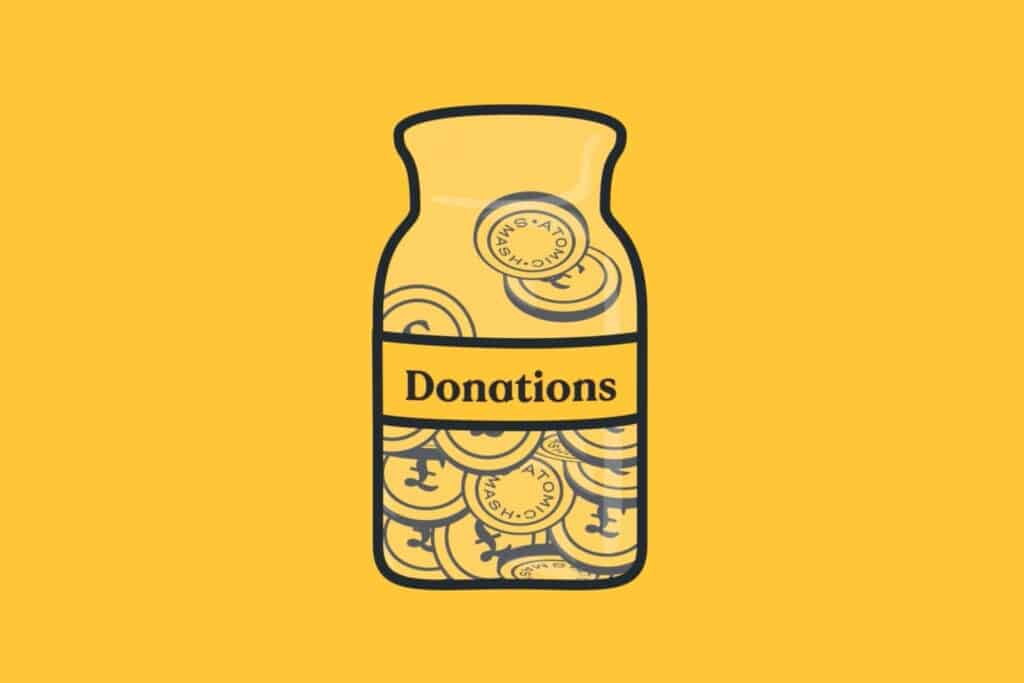Raise funds and awareness for your cause by optimising your site for donations
The global day of giving where charities and non-profits encourage people to support their causes.
Giving Tuesday, which falls on 29 November this year, can take the form of donations, volunteering, signing petitions or community events.
The day has gained popularity for the way it balances Black Friday and Cyber Monday, reframing the focus around people and causes that need support.
If you’re an organisation in the non-profit sector, this day can be a great opportunity to raise awareness around your cause and attract new and/or recurring donors.
To get the most out of this day, it’s important to plan ahead and optimise your site to make it as easy as possible for visitors to donate.
In this blog post, we’ll cover all the things you need to consider to maximise the opportunities that this day presents.
-
Establish clear goals
-
Monitor your page analytics
-
Maximise donation potential
-
Put yourself in a donor’s shoes
-
Review site usability and accessibility
-
Plan creative and omnichannel campaigns
-
Encourage recurring donations
Read all about it
Enjoying our insights? We have good news! You can get them every single month, delivered directly to your inbox when you sign up for our newsletter.
Where to begin
Establish clear goals
The first step in creating a digital strategy for Giving Tuesday is to work out (in measurable terms) what you want to achieve. When developing and implementing your strategy:
- Consider your target audience
- Determine your campaign message
- Get a clear picture of your resources
- Adopt an omnichannel strategy
- Repeat what works
Consider your target audience
Who is your existing donor base made up of? And are there any other demographics you want to attract through your Giving Tuesday campaign?
Have a clear target audience in mind and think about what they’ll want from your website while on the cusp of donating.
Determine your campaign message
It should be something that can be communicated easily and connects deeply with your target audience.
Get a clear picture of your resources
This includes budget, staff, existing site content that can be used, and the timeline you have to pull it all together.
Adopt an omnichannel strategy
Think about all the channels where your organisation is present. How you will adapt your message to the needs of each platform?
Repeat what works
What has worked for you so far? Plan how you can repurpose, replicate or rework it into this campaign.
Looking for inspiration?
Find out what’s possible for your non-profit’s website by checking out some of our case studies.
Monitor your page analytics
When users visit your website, every interaction they have reveals valuable insights into their wants, needs and points of frustration. So analytics tools are crucial to any organisation with a digital presence.
Site analytics tools allow you to capture this data, and they will often feed it back in the form of insights and visualisations. With the right tools and settings enabled, you’ll be able to answer the following questions:
- Who is visiting your site?
- How are they finding it?
- What strategies are most effective at driving traffic to your site?
- What content are people most (or least) interested in?
- How many of these visitors are donating or offering some kind of support?
- Who is donating?
- What are people searching for within the site?
- Are there any groups you want to reach that you aren’t right now?
Not only does having this data enable you to tailor your website to your audience’s needs, it also gives you concrete figures that you can use when approaching large organisations for funding.
Google Analytics is a great option for your analytics as it offers in-depth data and is also completely free – but if you’re already using GA, it’s time to start thinking about GA4.
For organisations with WooCommerce stores, we highly recommend Metorik for reporting.
Maximise donation potential
Engaging landing pages
The average web user spends about 15 seconds on a page, which doesn’t leave you with much time to make a case for your cause.
To maximise your donation potential, your campaign will need a landing page that is well-designed, easy to navigate, responsive to different devices and contains content that conveys your message clearly.
This can sometimes be a challenge for organisations with less resources to invest in digital marketing.
Even if you’re on a limited budget, planning your strategy ahead of time and utilising free resources where possible will allow you to take advantage of increased traffic on Giving Tuesday.

When assessing what needs to be done on your site, some questions you should ask are:
- Is the donate button easy to find and use?
- Does your site communicate why people should donate?
- Does your content communicate how the funds are being used?
Call-to-action to donate
Is the donate button easy to find and use?
Having the donate button in your site’s header in a bright, eye-catching colour will save users having to search through menus or scroll down the page.
It’s also helpful if the button appears on every page of your site.
Why people should donate
Does your site communicate why people should donate?
Although making sure your payment options are functional and secure is important, your website should be more than just a platform to process payments. You have an important story to tell.
How funds will be used
Does your content communicate how the funds are being used?
68% of donors say that knowing how their money is helping a cause is important to them.
Considering the donor journey
Put yourself in a donor’s shoes
With website and app-based donations on the rise, it’s important to consider how your website can meet this need.
The best way to understand the mindset of a possible donor is to walk through their journey on your website. One way to do this is to make a test donation on both the desktop and mobile websites and pay attention to how easy the process is.
If the donation link was hard to find, or if the payment process seemed complex, then chances are there are visitors to your site who have felt the same way – and might have even been put off donating.

When creating a seamless donor journey, there are four steps to consider:
- Awareness: A potential donor becomes aware of your organisation or cause
- Engagement: They visit your site to learn more about your cause and what you do
- Conversion: Your site hits the spot and conveys the right messages in the right way, and they decide to donate
- Ambassador: They continue to be associated with your cause, either through more financial donations, social media sharing or volunteering their time
Review your site’s usability and accessibility
Making sure that your website is accessible to people with disabilities is not just good business practice, it’s also a legal requirement in both public and private sectors.
As public-facing organisations, it’s particularly important for non-profits to make sure their website caters for people with different ability and access levels. This is especially if your organisation’s services and fundraising is aimed at helping people with disabilities.
Below is a checklist of factors to consider when auditing your site’s accessibility:
1. Optimise your images
Make sure that all your images are optimised for the web, and include alt text that can be picked up by screen readers and other assistive technologies used by users with visual impairments.
2. Ensure that videos include closed captions or transcripts
If your site hosts video content, you should ensure that all videos have closed captions or transcripts included.
YouTube offers a free closed-captioning service for its video formats. You can either upload your own, or use YouTube’s speech recognition technology to add captions automatically.
3. Accommodate for different screen sizes
You want to make sure that your content is accessible for users viewing your site on a mobile device.
Part of this is ensuring that the page formats correctly but it also means making sure fonts are large enough to be viewed easily, enlarging graphics and icons and using magnification software. Doing this can increase your reach.
4. Make sure headings and content are logical and easy to find
Use headings to separate text, have clear and short captions that can be read out easily by screen readers, and ensure that links are labelled properly so accessibility software can pick it up easily.
For example, ‘click here’ doesn’t provide any real context – instead, be specific.
5. Use accessibility tools to get a sense of what needs to be done
There are plenty of helpful resources out there to help you, including The World Wide Web Consortium (W3C), WAVE Web Access, and AbilityNet.
Plan creative and omnichannel campaigns
When planning campaigns, for non-profits, it’s important to strike the right balance between raising awareness about why donations are needed while still keeping your tone friendly and engaging.
It’s also important to remember that people will be engaging with your organisation across multiple channels, not just your main website.
Other channels to consider include social media, email marketing, and mobile apps, or special campaigns also run through a section of your website, like auctions.
Having to manage multiple channels might seem like a challenge, but it’s also an opportunity to get creative with your messaging using things like gamification and interactivity.
Peer-to-peer fundraising is another way to engage with your donors. This helps raise awareness about your cause and encourages people to participate actively. A 2021 study found that peer-to-peer fundraising generated $154 million, a 30% increase on 2020.
Our client The Grand Appeal, the official charity of Bristol Children’s Hospital, uses both interactivity and peer-to-peer fundraising in their strategy, and recently organised an auction.
Funds raised through the charity go towards providing families of critically ill children with accommodation while their child is in hospital, and financing medical research.
The site also contains an interactive Star Tribute Sky, a digital version of the physical Star Tribute Wall in the hospital. The page allows families the opportunity to post tributes to loved ones in the form of stars in the sky, while also being able to fundraise for the hospital in their names.

Turning one donation into many
Encourage recurring donations
Although Giving Tuesday is an opportunity for a boost to your funding right now, it’s also an opportunity for the future. You can turn the extra site visitors and one-off donors into recurring donors.
Most charities will agree that recurring donations allow them to plan ahead better, create clearer forecasts of how much money they will have in the future, and plan projects ahead of time.
To encourage this, you should seek to make it as easy as possible for your site visitors to become a regular donor. There are several ways you can do this, such as:
- Encourage them to become email subscribers
- Set up automated reminders
- Have a wide range of payment methods
- Most importantly, thank them for their generosity!
Encourage them to become email subscribers
Giving people the option to sign up for email newsletters when they make a one-off donation.
This way, they can stay up to date with your charity’s work and may be motivated to donate again in the future.
Set up automated reminders
Send reminders to update details if donations fail. Sometimes people simply forget to update their payment details.
A gentle email reminder with a link to a page on your website where they can manage their donations is a simple, tactful way to give people the opportunity to continue donating.
Have a wide range of payment methods
Make sure you accept donations across various platforms and formats, so there is a payment method that your donors can use.
Choose payment methods that people are familiar with, will trust, and are convenient, while making it easy to repeat their donations in a way that is relatively hassle free.
Most importantly, thank them for their generosity!
Thanking donors for their generosity goes a long way. Donors are 4 times more likely to give again if they’re thanked within 48 hours.
WWF’s website is a great example of a major charity that incentivises various types of donations.
On their ‘Donate’ page, the option to switch from a one-off donation to monthly donations is clearly shown to users, and they have the option to donate over the phone too.
There are also clear user journeys to become a member, adopt an animal, pay in fundraising or contribute to a particular fund like the Amazon Appeal or the Climate Crisis Fund.
Takeaways
When done correctly, Giving Tuesday can be a great opportunity to raise awareness for your cause and get more donors in the short term and in the long term.
These are the key things to remember:
- Establish clear goals
- Monitor your page analytics
- Maximise donation potential
- Put yourself in a donor’s shoes
- Review site usability and accessibility
- Plan creative and omnichannel campaigns
- Encourage recurring donations
With an increasing preference to giving online donations, organisations with a strong digital presence will see the best results on Giving Tuesday and into the future.
In order to achieve this, it’s important to have a site that can be adapted easily to changing circumstances. In fact, by investing strategically in your website you may never need a new site again.
Read more about evolving a website that takes charity donations.
Site launch is just the beginning
We’re experts at WordPress, WooCommerce and CRO. Find out how we can help you grow long-term.